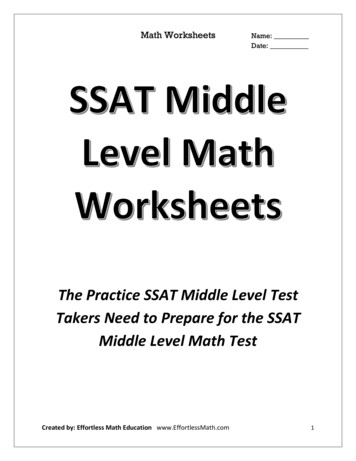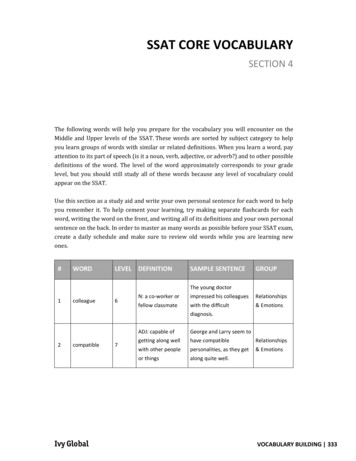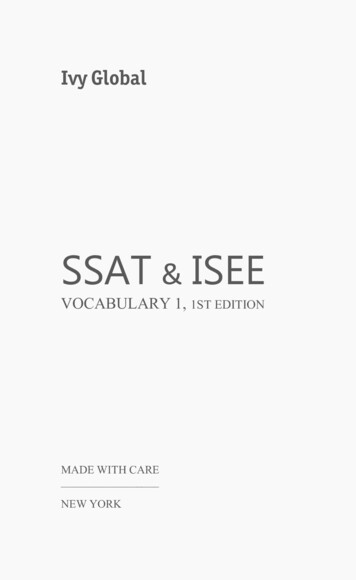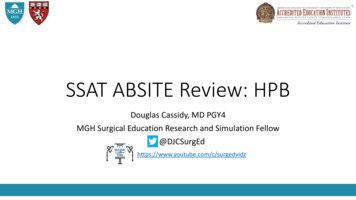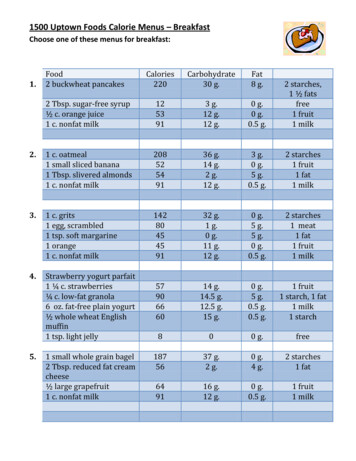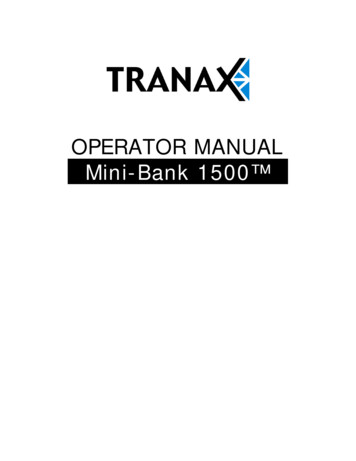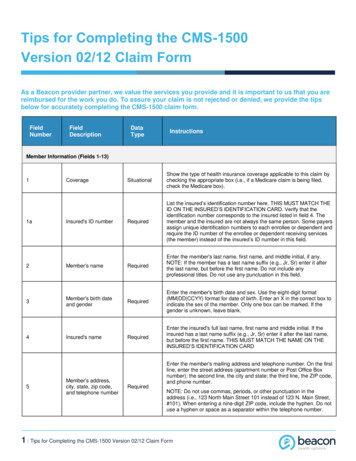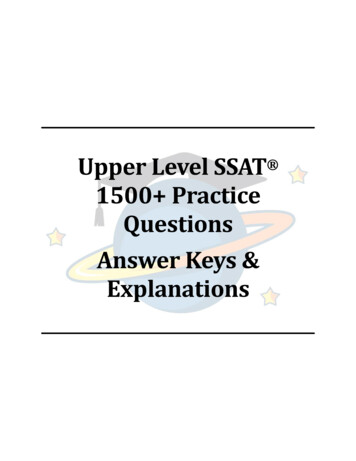
Transcription
Upper Level SSAT 1500 PracticeQuestionsAnswer Keys &Explanations
Table of ContentsPractice Test 1. 4Section 1 – Quantitative . 4Section 2 – Reading . 5Section 3 – Verbal . 7Section 4 – Quantitative . 10Section 5 – “Experimental” . 11Quantitative Reasoning & Mathematics Achievement . 12Number Concepts & Operations . 12Integers . 12Decimals. 12Fractions . 13Percents . 13Order of Operations . 14Number Theory . 14Rules of Divisibility . 15Place Value . 15Time/Money Concepts. 15Estimation . 16Unit Analysis . 16Computational Clue Problems . 16Sequences, Patterns, Logic . 17Algebra . 17Common Factor . 17Factoring. 18Ratio and Proportions . 18Word Problems . 19Interpreting Variables. 21Equations Based on Word Problems . 21Equations Based on Illustrations. 22Rational Expressions . 22Exponential Expressions. 23Radical Expressions . 23Polynomial Expressions . 24Linear Equations . 25Quadratic Equations . 26Inequalities . 27Scientific Notation . 27Geometry & Measurements . 28Pythagorean Theorem . 28Perimeter, Area, Volume . 29Problems Using Shapes and Angles . 30Coordinates . 31Transformations. 31Slope . 32Spatial Reasoning. 32Data Analysis & Probability . 33Mean, Median, Mode . 33Probability . 33
Counting. 34Set Theory . 35Reading Charts & Graphs . 35Verbal – Synonyms. 36Introductory. 36Intermediate . 38Advanced . 39Verbal – Analogies . 41Guided Practice – Antonyms . 41Guided Practice – Association . 42Guided Practice – Cause-and-Effect . 42Guided Practice – Defining . 42Guided Practice – Degree/Intensity. 43Guided Practice – Function/Object . 43Guided Practice – Grammar . 44Guided Practice – Individual/Object. 44Guided Practice – Noun/Verb. 44Guided Practice – Part/Whole. 45Guided Practice – Purpose/Object. 45Guided Practice – Type/Kind. 45Guided Practice – Whole/Part . 46Guided Practice – Synonym . 46Mixed Practice 1 . 47Mixed Practice 2 . 47Mixed Practice 3 . 48Mixed Practice 4 . 48Mixed Practice 5 . 49Mixed Practice 6 . 49Mixed Practice 7 . 50Mixed Practice 8 . 50Mixed Practice 9 . 51Mixed Practice 10 . 51Reading Comprehension . 52Fiction . 52Non-Fiction. 55Practice Test 2. 60Section 1 – Quantitative . 60Section 2 – Reading . 61Section 3 – Verbal . 64Section 4 – Quantitative . 66Section 5 – “Experimental” . 68Practice Test 3. 68Section 1 – Quantitative . 68Section 2 – Reading . 70Section 3 – Verbal . 73Section 4 – Quantitative . 75Section 5 – “Experimental” . 77
Practice Test 1Section 1 – Quantitative1.D. Numbers – Fractions. Convert all the fractions to have the lowest common denominator, which is 15. 103571 6 – 3 13 .151515152. C. Geometry & Measurements – Perimeter, Area, & Volume. The hash marks show that the triangle isequilateral, so each side is 12. We can split any equilateral triangle down the middle into two congruentright triangles. Here, each right triangle has a base of 6 and a hypotenuse of 12. We can use thePythagorean Theorem to find the height, which is 6 3, so the area of the entire triangle is ½(12)(6 3) 36 3.3. B. Numbers – Percents. We can find the number by applying the formula for percent: 12 0.25x. x 48.70% of 48 is equal to 0.7(48) 33.6.4. C. Data Analysis & Probability – Reading Charts & Graphs. The sum of the amounts of money in the accounteach year is 12,000 10,000 22,000 21,000 18,000 83,000. The sum divided by the number ofyears is 83,000 5 16,600, which, rounded to the nearest thousand, is 17,000.5. D. Geometry & Measurements – Problems using Shapes & Angles. The triangle inequality theorem statesthat a side of a triangle has to be less than the sum of the other two sides, or a – b c a b. This is onlycorrect for 4 6 8, 6 8 4, and 4 8 6.6. D. Data Analysis & Probability – Mean, Median, Mode. Of the prices given, the mode is 15,000. Thecomplete number set, in ascending order, is { 9,000, 12,000, 13,000, 15,000, 15,000, 15,000}. Thenumbers that are in the middle of this set are 13,000 and 15,000; to find the median, add these 213000 15000numbers and divide by 2. 14,000.27. E. Algebra – Interpreting Variables. Each month, Joe’s plant grows by 13%, which means 0.13 times itsheight is added each month. The plant always has its original height, which is represented by 100%, or 1.Therefore, to find the plant’s height after h months, multiply the height by 1.13 times itself h times.8. E. Algebra – Word Problems. This scenario can be represented by the equation s(6 – 2) 300. 4s 300, sox 75. In context, John will have to sell no fewer than 75 sandwiches to make 300.5035009. C. Numbers – Estimation.is close to , which is 71.4% (simply divide 5 by 7). This is closest to 75%.66370010. A. Algebra – Interpreting Variables. Simon’s cards are represented by x; since Julie has two times as many,she has 2x cards.11. B. Algebra – Ratios & Proportions. We will solve by using a proportion. First, determine which values will𝑐ℎ𝑎𝑝𝑒𝑟𝑜𝑛𝑒𝑠be in the numerators and denominators of your ratios. For example:. Next set up �𝑛𝑡𝑠proportion: . Find the cross products: 3 x 20 12. Then, simplify: 3x 240, and solve: x 8020𝑥students. There were 80 – 12 68 more students than chaperones.D. Numbers – Unit Analysis. There are 176 pints of rice per bag (22 8 176). 176 pints 35 bags 6,160pints.D. Algebra – Quadratic Equations. For the product to be equal to 0, either 3x or x – 5 must be equal to 0.So, the only one of the answer choices that will work in the equation is 5.A. Algebra – Linear Equations. Distribute 5 over (x 2.4) which yields 5x 2.4 5x 12. Subtract 5x fromboth sides of the equation which will result in 2.4 12. This is a false statement since 2.4 12. Hence,there is no solution or 0 solutions.A. Algebra – Inequalities. To solve the inequality, or find its possible solutions, multiply both sides of theinequality by 3.A. Geometry & Measurements – Pythagorean Theorem. The area of each square is the length of one sidesquared (s2). Based on the information given in the problem, we know from the Pythagorean Theoremthat a2 b2 64 17. Therefore, c2 81. Since c2 x2, x2 81 and x 9.E. Numbers – Sequences, Patterns, Logic. 100 is evenly divisible by 7 only 14 times. This means that we canget from 100 down 14 7 98 places, to 2, before going negative. 2 – 7 –5.B. Algebra – Factoring. All three terms have a common factor of x2, so that can be factored out to yieldx2(x2 – x – 6). Find factors of 6 that add to 1: 2 3 6 and 2 –3 1, so the equivalent expression is x2(x 2)(x – 3). You can multiply the factors to check your answer.B. Data Analysis & Probability – Counting Principle. Amanda and Danielle must sit next to each other inseats 1-2, 2-3, or 3-4. That is three possibilities, leaving two seats open for the other two girls. That lookslike there would be six possibilities, since 3(2)(1) 6. However, Amanda and Danielle can change theirpositions when they are seated next to each other, so the answer is 6(2) 12.
20. B. Algebra – Rational Expressions. The numerators can be multiplied to yield 2 3 6. The denominatorscan be multiplied as well: (x 3)(x 5). Use the distributive property: x2 5x 3x 15 x2 8x 15. So6this expression is equivalent to 2.𝑥 8𝑥 1521. C. Algebra – Scientific Notation. 8.7 3 26.1, therefore (8.7 103) 3 26.1 103. Convert this intoproper scientific notation by moving the decimal 1 place to the left, which increases the power by 1.22. C. Geometry & Measurements – Slope. Perpendicular lines have slopes that are negative reciprocals of eachother. To find the slope of this line, first rearrange it into slope-intercept form y mx b. 2y –3x 10 or332y – x 5. The slope is – , which means its negative reciprocal is .22323. B. Data Analysis & Probability – Probability. There are 20 candies in total in the box. The probability of41selecting a cherry candy is the number of cherry candies, divided by the total ( ). The first candy has20 5not been replaced, and so now there are 19 candies left in the box. The probability of selecting a green5apple out of these is now . To find the probability of these two events both occurring, multiply the two11951probabilities together. .5 19 1924. C. Algebra – Polynomial Expressions. Use the distributive property to multiply. Each term in the firstpolynomial needs to be multiplied by each term in the second, which yields: x3 3x2 2x 5x2 15x 10.Then combine like terms: x3 8x2 17x 10.25. E. Geometry & Measurements – Spatial Reasoning. There are 4 squares each shaped by 4 triangles, and 1outer square that is the whole figure. There is 1 large square in the center (which is filled to look like adiamond), and there are 4 smaller squares (also tilted) each shaped by 2 triangles within this largesquare.Section 2 – Reading1.E. Tone/Mood/Style. The author describes a lazy afternoon spent admiring his surroundings while on aboat. He paints a tranquil scene. There is no language that would imply this the mood is annoyed. Whilethe mood is positive, the author is too laid-back for the mood to be described as amused. Melancholywould imply sadness, which is not a feature of the poem. Restlessness would have the speaker movingaround – quite the opposite of his lazy day on a boat.2. B. Detail. The stream is so calm that there’s not a ripple. Bubbles would produce ripples, whichcontradicts the initial clause in the line. We don’t know the temperature, so cold is not an option. The poolis filled with water, but the fact that the author contrasts “placid” with “no ripple stirs” tells us the wordhas to do with movement.3. D. Tone/Mood/Style. In this phrase, the sky is granted human agency, as shown by the verb “gives.” This isan example of personification. Metonymy is substitution of an attribute of a thing for the thing itself –“suits” for “business executives.” Simile is a comparison using “like” or “as.” Parallelism has to do withsentence structure. Meter is a way of measuring syllables in poetry.4. E. Inference. The natural beauty described by the author is the world’s wide wealth, and it’s free for theauthor to appreciate. We don’t know how skilled the author is as a fisherman. There’s nothing to suggesthe will be receiving an inheritance. The sky is described as divine, but the wealth is not particularlyconnected to the sky, nor is the sky likened to precious gems.5. B. Main Idea. The author describes his beautiful experience of nature while relaxing in a boat. The authorneglects his fishing. He compares looking at nature to being wealthy, but is not primarily concerned withwealth. He is not promoting an opinion, but instead is documenting his surroundings. While he doesdocument different types of wildlife, he is more concerned with the beauty of the wildlife and generalscenery.6. C. Detail. The passage states that Traylor was “aided by Shannon’s professional networks,” which allowedhim to exhibit his art in “museums throughout the country.”7. A. Tone/Mood/Style. The author’s tone remains light-hearted throughout the passage, and thedescriptions of Traylor are full of admiration. The passage does not question, analyze, or criticize.8. E. Detail. Traylor’s work was initially considered to be an “exemplar,” or example, of “folk art.” In thiscontext, “exemplar” most nearly means “representation.”9. B. Inference. The passage states that, “Now, however, the artist’s works are deemed to fit squarely withinthe canon of contemporary, twentieth-century American art.” This suggests that today’s audiencesadmire his work and believe it to fit in the time period.10. A. Main Idea. The passage covers Traylor’s early life as a sharecropper and his artistic immersion later inlife. While the passage does mention Shannon and some art trends, it does so in context of Traylor’s lifeand accomplishments.
11. D. Detail. In context, cacophony is used to describe the harsh mixture of sounds produced by noisesreflected on a city street. Racket is the word that best describes this phenomenon.12. E. Inference. The author explains that softer surfaces will reflect fewer vibrations than harder ones, likestone or metal. The snow has the effect of absorbing some, but not all of the sound waves. A stone orpiece of metal would probably reflect all of the ripple, while a speck of dust or small feather none. A sheetof cloth would absorb some, but not all of the ripple.13. C. Main Idea. The author mentions a cold winter’s day, how ripples spread across water, and how thebrain process sounds, as well as the way echoes are created, in order to explain why things seem morequiet in the snow.14. E. Tone/Mood/Style. The purpose of the passage is to tell more about why something happens. This ismost similar to what happens in a science textbook. This is not a creative or fictional work, neither does itdescribe a particular event or occurrence.15. E. Detail. While the reflective quality of air may contribute to noise levels, it is not addressed by theauthor of the passage. The author claims that the hardness of exposed surfaces, people, the presence ofporous materials, and the number of reflective surfaces all contribute to noise levels.16. E. Detail. The narrator describes various sights that lead the boy to “gulp” and “look brave.” All of theserepresent novel experiences of independence and life in a big city. The boy’s inexperience is revealed bythese things, but is not the thing that strikes him. The author goes on later to discuss his age/perspective.17. C. Inference. The narrator is overcome with emotion as he recalls his own experiences and empathizeswith the boy’s experiences. The narrator opens a coconut in the past, not in the present. There is noevidence that the narrator has a child. The narrator is a passenger, not the driver. The boy is said to notbe crying.18. D. Main Idea. The narrator describes the boy as inexperienced (“he’d set foot on London stones for thefirst time”) and naïve (“tried to look brave”). He then mentions how “it’s the young that [he pities]”because they are “set toward the road along which we have travelled, that trouble me”. He mentions thathe pities his own coming-of-age experience. While the flowers are a powerful symbol of innocence, this isnot the main sentiment, as it is the tragedy of the loss of this innocence that is unavoidable.19. C. Tone/Mood/Style. Hyperbole is the use of exaggeration, not meant to be taken literally, to emphasize apoint. In this case, the narrator cannot literally give worlds, but uses the expression to emphasize howmuch he wanted to speak to the boy. The other answer choices contain other examples of figurativelanguage, or are not figurative language at all.20. E. Inference. The coconut story is one of youthful hope that gets dashed by reality. The young narratorhopes the coconut will be sweet, but it turns out to be sour. The fact that he remembers this 65 yearslater tells us that this memory has not faded, but is still as powerful as ever. This strengthens the narratoras a character, not weakens.21. D. Tone/Mood/Style. The question asks how the narrator feels when he recounts his experience; it doesnot ask how his younger self felt at the time. While the younger self felt at one point determined andhopeful, this is not how his present self feels. The narrator feels nothing but negative emotions when herecalls this story, ruling out “optimistic,” “gleeful,” “satisfied,” and “determined.” The only choice with twonegative emotions is “melancholy” and “bitter.”22. A. Tone/Mood/Style. The passage passionately advocates for the removal of DST while using fairlyinformal language throughout. The passage cannot be considered to be “passive,” “ambivalent,”“abstract,” or “theoretical” since the author argues strongly for one point of view and uses specificexamples.23. D. Inference. The “tradition” and “practice” here is that of changing the time. The author argues stronglythat people should no longer do so because the purpose of doing
Practice Test 1 Section 1 – Quantitative 1. D. Numbers – Fractions.Convert all the fractions to
